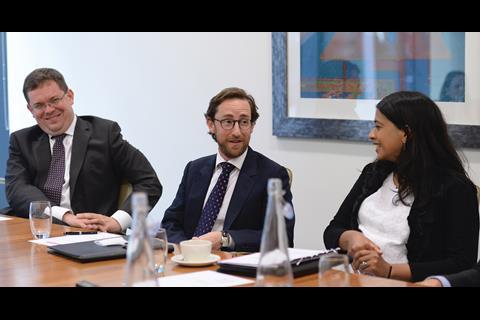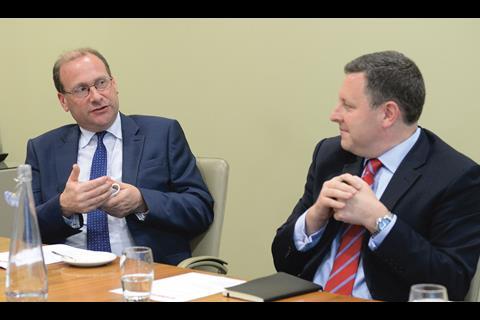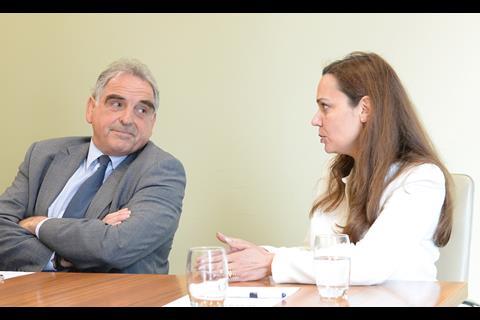High-net-worth people with $1m or more to invest want advice from private client lawyers on issues ranging from tax to trusts. Eduardo Reyes reports from the Gazette’s latest roundtable.
A partner at a leading corporate firm quipped: ‘We always called that “dead and dying” work. Good luck.’ That was in response to a lawyer attending our latest roundtable who gave notice that they were leaving to join a practice specialising in private client.
Today, that same partner phones regularly to ask if any of those ‘private’ clients have corporate needs that could be referred on to him.
The anecdote is telling. The practices from which the corporate partner is seeking referral work now commonly fall under the heading ‘private wealth’. And this is a rapidly growing market, as Gazette readers will be aware.
According to an annual research paper by consultancy Capgemini, in 2014 some two million fortunate souls became ‘high-net-worth individuals’. This is defined as having $1m to invest, excluding the value of a main residence.
James Carter, managing partner of Charles Russell Speechlys, reflects on how the market has changed: ‘Before the credit crunch your high-net-worth clients would have borrowed 90% of the cost of an asset from a bank – they could buy a commercial building in the City of London for £100m and get £90m of bank debt to do it.
‘Times have changed and the debt markets have dried up. Now it’s the other way around – our clients are the ones who are lending the money as they search for increased income returns.’
The designation ‘private wealth’ does not have easily discernible parameters. As Mishcon de Reya solicitor Charlie Sosna says: ‘The interests of the high-net-worth – or ultra-high net-worth – individual can be so wide-ranging that you can’t really put a boundary around it like you can in other areas of law.’
With an individual or a family, he says: ‘It’s their personal interests; their family interests; their business interests. And all that comes with that.’
In consequence, describing law firms that are focused on private wealth as ‘boutique’ or ‘niche’ can be misleading. Maya Prabhu from Coutts Institute points out that these clients require a diverse range of professionals who are also able to collaborate: ‘At Coutts, we regularly work with our clients’ other advisers. The more “joined up” we can be, the better the service.’
This multidisciplinary approach has been one notable development of the last decade, she avers.
Michael Maslinski of family office business Stonehage and Fleming Family & Partners suggests that the very perception of what constitutes a private client lawyer needs to be ‘relaunched’. ‘People need to understand why it is much more interesting than many other areas [of law], where you can become so specialised you’re focused on one [area] all the time.’
Withers partner Sophie Dworetzsky adds: ‘You find you can be working on an initial public offering – but you’ll also be working on a private trust company and collaborating with our family team on a pre-nup. The landscape of private wealth has expanded.’
The UK has moved toward a US model of wholly integrated advice, she notes: ‘You have to put on your “tax” hat, your “trust” hat, your “corporate” hat – maybe even your “litigation” hat.’ As Dworetzsky points out in passing, today there are some career similarities between the private wealth lawyer and corporate counsel.
Culture clash
How long ago it seems that some of the largest law firms ditched their private client departments. Then they were markedly less profitable than disciplines such as corporate M&A, capital markets and banking work. Private client lawyers from the likes of Freshfields Bruckhaus Deringer, Cameron McKenna and Allen & Overy moved in teams to other firms west of the City.
As the role of private wealth in the global economy increases, there is scepticism about the ability of large commercial firms to rebuild their capability, as some are rumoured to want to do.
Maslinski argues: ‘They lost an important part of the chemistry of the whole firm and probably didn’t understand the extent to which that impacted on the culture. So when they then tried to restart private client departments, [they found] it’s not just another service line.’
He adds: ‘People who want business referred to them from a private client have also got to understand the culture of private client work.’
Prabhu points out: ‘To get down to brass tacks, the billing cycle would be very different. You need to be at the end of the phone.’
Privacy
One topical subject of concern for clients, and by extension a challenge for their professional advisers, relates to a desire for privacy. Often, Farrer & Co partner Nick Dunnell says, ‘privacy overrides other considerations’.
Privacy is one issue colouring attitudes to the UK-Switzerland Tax Agreement, introduced in 2013, and the Common Reporting Standard (CRS). The latter allows for automatic exchange of information on wealth and income data between 90 countries, 58 of which are committed to implementing the CRS in 2017.
The amount of data that is now systematically shared or easily available is a common headache, Dunnell points out. He cites the mass of private client data placed in the public domain and with revenue authorities by a ‘disgruntled’ HSBC Switzerland employee in 2008.
‘There’s a general uncertainty or wariness about where all this information ends up,’ he says. ‘You want to ensure that information doesn’t go to authorities that don’t need to have it.’
Under CRS, ‘wealth’ (and not just income and gains) is reported. ‘Clients who are entirely compliant ask, “Why do we need to disclose this? It’s not disclosable for the purposes of my tax return, so why do I need to disclose it?”’, Dunnell adds.
‘You’re right to draw a distinction between what one might call “legitimate” privacy and “illegitimate” privacy,’ Piers Master, partner at Charles Russell Speechlys, interjects. ‘No one around this table is for a minute going to be saying that we’re sheltering tax evaders, because we’re not. I think the industry is very alive to that.’
Any objection, says Master, rests on a scenario where clients ‘pay the right amount of tax, but as a result of information exchange end up having the information disclosed to some less-than-savoury government in a difficult part of the world’.
A client’s personal safety could be put at risk, he stresses.
In this respect CRS was a missed opportunity, Master argues: ‘Governments haven’t given enough thought to the interests of the private individuals for whom tax evasion is the last thing they would consider; whereas the safety of their family is always the first thing [on their minds].’
Offering an insight into her clients’ other priorities on disclosure, Prabhu relates: ‘Families may not have talked about the extent of their wealth with their children. They think about playground conversations [that could arise]. All of those things can be very damaging emotionally unless there is some privacy and control of that information and the manner of its disclosure.’
The link between private wealth and business activity leads Carter towards Luxembourg as a growth jurisdiction. It has moved from its more traditional base of multinational corporates to an attractive regime for privately held structures.
He predicts: ‘Luxembourg will become a more significant jurisdiction for private wealth. Partly as a result of increased scrutiny around corporate structures, the country has extended the range of asset-holding vehicles with the introduction of foundations and a choice of limited partnerships. These are attractive to the private wealth sector.’
Traditionally, trust structures have been used by family offices to manage wealth. But, Dworetzsky suggests, ‘one thing that could also get quite interesting from an EU perspective is non-trust structures’. She suggests corporate foundations may suit some families better.
With regard to Switzerland, it is not just the content of the UK-Swiss agreement that has led clients to question their use of Swiss banks and look elsewhere, Sosna adds. Poor execution has also created uncertainty for clients who have no intention of failing to comply.
‘I think they [the Swiss banks] were used to very low standards of reporting. They took pride in their confidentiality,’ he notes. ‘Then the UK-Swiss tax agreement came in and all of a sudden all these forms started flying around. I remember having conversation after conversation with different bankers in Switzerland at the time. They just didn’t get it.’ He recalls scenarios where ‘it was like me pointing to them and saying, “This is black,” and they respond, “No – I think it’s white”’. As a result, he says, ‘many clients lost patience: a lot of them decamped to Singapore and Hong Kong’.
Another ill-judged response to the demands of closer scrutiny has been the decision of many banks simply to pass on the additional compliance cost to their HNW customers. Dworetzsky says: ‘That’s causing frustration and I’ve seen clients move to the far-east as a result.’
At the table
Eduardo Reyes, Law Society Gazette; James Carter, Charles Russell Speechlys; Alistair Morgan, Mayfair Private; Sophie Dworetzsky, Withers; Michael Maslinski, Stonehage FF&P; Maya Prabhu, Coutts Institute; Piers Master, Charles Russell Speechlys; Charlie Sosna, Mishcon de Reya; Dhana Sabanathan, McDermott Will & Emery, Nick Dunnell, Farrer & Co
Look east
Asia is indeed a growing source of instructions, with family-owned businesses central to economic growth in much of the region. ‘Family charters’ are increasingly important here.
As defined by Coutts, a family charter or constitution ‘documents the shared vision and values of the family and its policies regarding the ownership and operation of the family business. Although it is not a legally binding document, it contains several statements of intent which reflect the consensus view of the family shareholders’.
Prabhu notes: ‘In Singapore, Indonesia and Malaysia principally, this is now on the agenda more and more.’
Issues can arise relating to the content of such charters as key roles in a family shift and the next generation comes into the equation. ‘The children go to Ivy League universities and bring back fresh ideas of how the business should be run and professionalised.’ This is not just about ‘passing on the torch’ however; revised arrangements must respect ‘the very traditional Asian hierarchy between generations’.
Prabhu adds: ‘The big transition is from the second to the third generation, when you move from siblings running the business to a group of cousins. What’s important is the discussion that the parties go through to arrive at what is in the document, because these are typically matters that have been brushed under the carpet for years.’ Professional advisers have a key role here.
An accountant by background, Alistair Morgan of Mishcon de Reya joint venture Mayfair Private describes one scenario that required attention. This involved ‘the eighth and ninth generation of a family that owns a very big private business in India and Indonesia’.
They had established a family charter 25 years ago which stipulated that all family members would be treated equally from a financial perspective, whether they were involved with the business or not.
He recalls: ‘The sticking point was that only male heirs of the family could be involved with the management of the business. The female heirs were not to be involved because they might marry into families of competing businesses and therefore couldn’t be trusted with confidential information. There was also a general assumption that the male heirs might also marry into those families, but that for some reason they wouldn’t share any information with their spouses.’
By the ninth generation there were four male heirs, none of whom lived in India or had any interest in running the family business. He continues: ‘There was, however, a very good pool of female heirs who were very interested. We were asked to try and help the eighth generation running the family at the moment to change the charter to permit female participation in managing the business. It was quite a difficult one.’
When disputes arise within families they can, needless to say, be bitter and advisers are thrust into the spotlight. Sosna notes: ‘It tends to be a personal issue that kicks off the bigger dispute, perhaps an issue that stems from childhood, or a divorce that divides the family.’
In another scenario, family members who are not running the business come to believe that those who are may be doing a bad job.
The importance of not losing face is also an important consideration. A mediation that seems successful can simply prolong the life of a dispute. In terms of getting ‘closure’, one attendee observes, ‘it can be better to litigate and lose’.
‘You’re from a wealthy family,’ Dunnell posits. ‘[Let’s say] your main drive in life goes, but you have the wealth to perpetuate a dispute. It can be a heady mix.’ Disputes can also be deepened by the informality of family arrangements; the contractual safety measures present in most business arrangements were never put in place ‘because we’re all family’, Sosna relates.
An added complication relating to the location of trusts can be the limited choice of law firms available when litigation must take place in small offshore jurisdictions.
A final point of debate is the rise in ‘global citizenship’. As research by Barclays shows, 75% of the ‘global wealthy’ have lived in five or more countries. This has increased competition between countries looking to attract private wealth. Master relates: ‘I think over the last 12 to 24 months I must have been asked about citizenship options immeasurably more than was ever the case before. One of the themes of the private wealth landscape at the moment is the fact that it’s driven to an extent by political risk.’
Master notes reports of a rise in applications for EU citizenship from Russia and the Middle East via Cyprus and Malta. Sosna adds: ‘It’s not necessarily tax-driven – visa-free travel is also a big incentive for many clients.’
Trusted advisers
In summarising the value good lawyers can add for HNW clients, Maslinski notes: ‘It is the relationship aspect – what people damningly call “soft skills”, even though they are the hard part! Not only must you advise on the law, you must also be the confidant and adviser to people who have got to weigh legal and financial decisions against deeply personal matters.’
This extends to philanthropy, Dworetzsky says: ‘The areas where you see people becoming most emotionally engaged are family charters and philanthropy, and the two often go together. The link prompts questions such as “Who are we as a family? What is our ethos? What is the meaning of our wealth?”.’
Though he is not a lawyer, Maslinski’s experience of the family office leads him to conclude: ‘This is probably the most interesting area of law that you could be in, and the legal profession needs to become more aware of it. I think it could also lead the legal profession in relaunching itself in the modern age.
‘The idea that knowledge is your passport to a nice salary and a good position is gradually being eroded. But it’s the skill to apply that knowledge people need. You get much more of these skills on the private client side than you do dealing with professionals in other areas of the law.’
Eduardo Reyes is Gazette features editor
Kindly hosted by Charles Russell Speechlys



































No comments yet